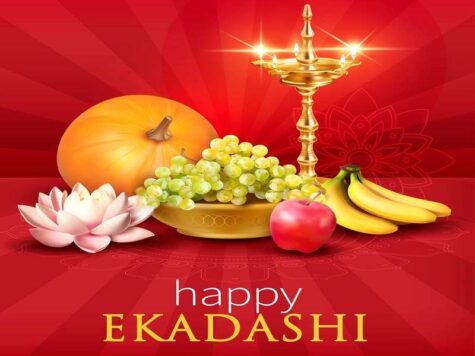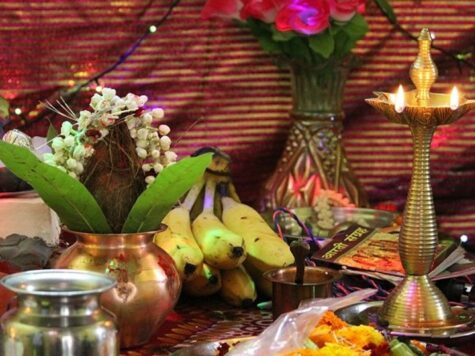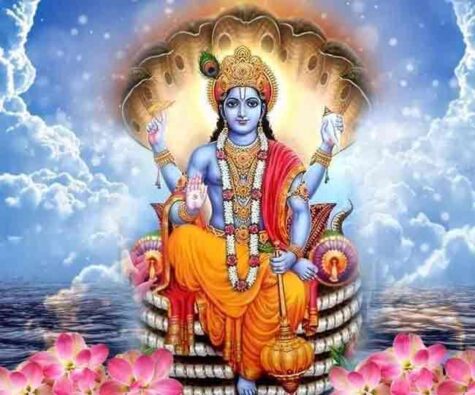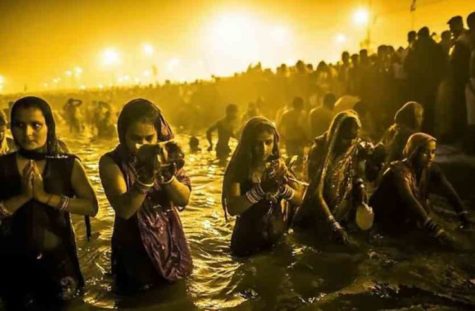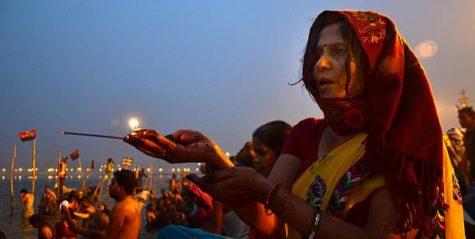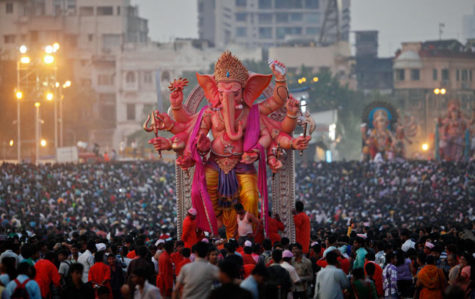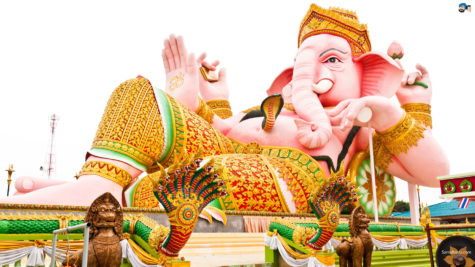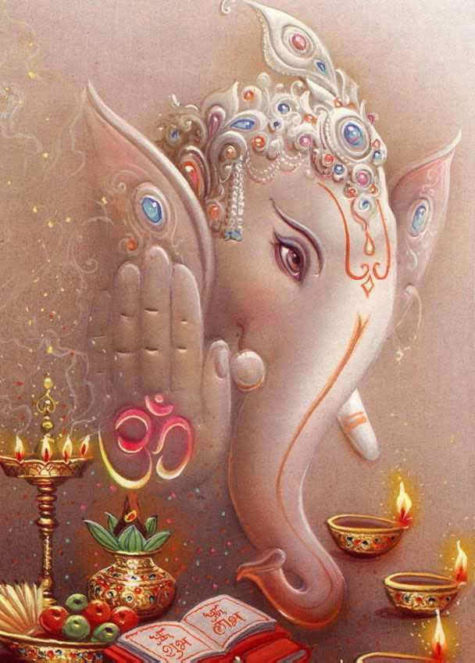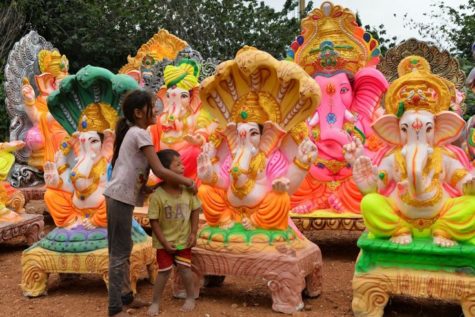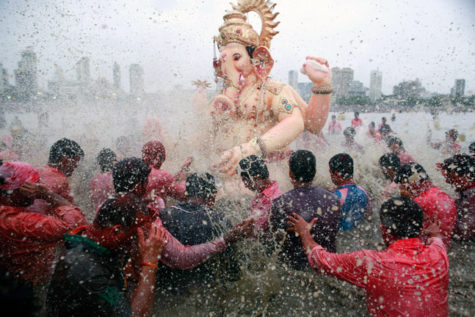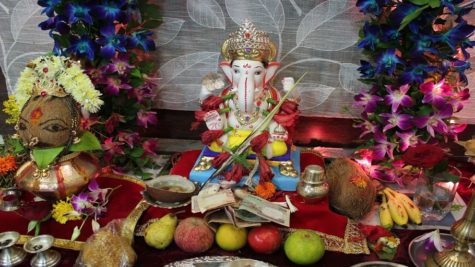Hindu
Ekādaśī Tithi, the eleventh lunar day (Tithi) between the New Moon and Full Moon is an important day in Hinduism and Vaishnavism tradition. Ekadashi, also spelled as Ekadasi, is a day of self purification, redemption and spiritual progress. It is also known as Hari Vasara because it is dedicated to Lord Vishnu, is a day of fasting and prayers for all Hindus.
Our current Calendar has the dates of these days listed for every month. It can be found here.
Those who fast on this day are considered to get rid of malefic planetary influences, experience happiness, and gain the right peace of mind to think of Ishvara and attain moksha. It is a day of Vishtikarana, a day of malefic influences. Vishtikarana coincides with the second half of Ekādaśī Tithi and is avoided for all functions associated with worldly prosperity.
Ekadasi occurs twice in a Lunar month, in the bright fortnight and the dark fortnight. It is recommended to do a strict fast which means not to eat and drink at all because food is filled with our sins and bad karma. On this day, taking food increases our bad fortune. but if we fast this day we “burn” bad karma and and increase good fortune.
Fasting gives the body a chance to give rest to the digest system, instead of regular heavy meals three times a day, more fruits and light food is consumed, by doing so person goes for more of a spiritual life. It also teaches better control over body and mind. One of the biggest gains is staying healthy.
It is also important to give the physiological system some rest once a while. It may be overworked due to overeating or indiscrimination in diet. These irregularities get rectified in one day. Thus the observance of Ekadasi has many advantages — physical, astral, spiritual — and because this day has connection with the relation of the mind and body together with the moon, it helps improve meditation and contemplation.
The reason is because the planet itself is in a certain state on that day, so if we keep our body light and available, our awareness will turn inward. The possibility of opening the door within is more on that day. If you have a full stomach, and you are unaware and dull, you will not notice it. So to stay alert and also to purify the body, you go without food on that day – you ate dinner the previous day and the next thing you eat is dinner on Ekadashi.
Hinduism puts forth the idea that spiritual ascesis during Ekadashi helps a person to “jump out” of life and death cycle. Ayurveda recommends fasting to improve one’s health. Follow your personal features:
- If you have “dosha kapha” – keep dry fasting.
- If you have “Vata” then drink lemon water.
- If you have “Pita” drink milk or juice (use 40% of milk and 60% of water, pour some sugar)
Depending on your state of health, work load, and other factors you can choose your personal diet taking into account the recommended food for the day.
If you are unable to go without food – because your activity levels are such and you do not have the sadhana to support you – you can go on phalahara or fruit diet, which is light on the stomach so that your inner doors will open. Forceful denial of food is not the point. The point is to make everything into a conscious process. We do not want to compulsively eat like this, we choose.
How to abide by Ekadashi
In the Ekadashi morning you should take a shower, calm down and clear your mind and body. It is important to understand that fasting is not just rejection of food or any other stuff. If you give vent to anger or moral deficiency – you are not actually keeping a fast, you are just not eating. Avoid daytime sleep, oil massage and shaving.
If you are not fasting eat no more than one time per day (after midday) during Ekadashi.
If you happen to miss the Ekadashi – you can do the fast it the next day (Dvadashi) and stop fasting on the 3rd day (Triodashi). If the Ekadashi coincides with dashas (the 10th lunar days) there’s no need to fast, buf if it coincides with the Dvadasha (12th Lunar day) it calls “pure Ekadashi” (Mahadvadashi) and it can be kept strictly.
Stop fasting the next morning 2-3 hours after the sunrise. The first meal should consist of fresh fruits or juices. Be careful with your ration. Your stomach is not working during fasting so do not overload it with heavy food when your fast is over.
It is recommended to prepare yourself for the first time fasting during the Ekadashi. Calm your mind and body. Do not overeat the day before fasting, do not take animal food. Vegetables, fruits, porridge are advisable. You can perform cleaning procedures (clyster, etc.). When you stop fasting drink juices, eat vegetables, fruits, cereals, etc. but not too much.
The Mantra For Ekadashi
The Vishnu mantra chanted on this day is:
“Om Namo Bhagavate Vasudevaya”
Hare Krishna maha-mantra to chant 108 times:
“Hare Krishna Hare Krishna
Krishna Krishna Hare Hare,
Hare Rama Hare Rama
Rama Rama Hare Hare
Or:
Hare Rama Hare Rama
Rama Rama Hare Hare,
Hare Krishna Hare Krishna
Krishna Krishna Hare Hare
Sources:
Mauni Amavasya, also known as ‘Mauna Amavasya’ is a unique Hindu tradition observed on the ‘amavasya’ (no moon day) during the Hindu month of ‘Magha’. It falls during the month of January-February as per the Gregorian calendar.
As name suggests it is the day of silence in Hinduism when people take pledge to observe one day fasting by not uttering a word throughout the day. It is believed that the water of the most sacred and holy river in Hinduism, the Ganga, turns into the nectar on Mauni Amavasya day. Due to this belief Mauni Amavasya day is the most important day in Hindu calendar to take holy dip in the Ganges.
If this date falls on Monday, (which it does in 2019), then its auspiciousness increases all the more.
The day is also celebrated as the birthday of Manu rishi. It is believed, Lord Brahma gave origination to Maharaja Manu and queen Shatrupa. Hence, this day is considered as the beginning of the creation of the universe.
Do’s and Don’ts For Today
- Silence is considered auspicious on this day.
- Wake up early in the morning and take a bath while keeping silence.
- Better yet, bathe in a river, lake or sacred pool.
- After bathing, offer Sun (fire) to the God.
- Silence on Mauni Amavas is of particular importance. If it is not possible to remain silent then do not speak bitter words from your mouth.
- In Vedic astrology the moon is said to be the factor of the mind. Restraining the mind by keeping a silence fast strengthens the mind.
- On this day there is also the law of worship of both Lord Vishnu and Shiva.
- The poor and the hungry should definitely have food. Offer food in grains, textiles, sesame, amla, blankets, beds, ghee and cows.
- Donations of gold or land can also be done.
- Remember the ancestors also on Mauni Amavas, this leads them to salvation.
- Both men and women should avoid having physical relations on this day. According to Garuda Purana, children born with sexual relation on the Mauni Amavas may have to face many kinds of problems in life.
- Men and women should avoid arguments. This brings an atmosphere of unrest to the house. It always gives birth to negative power.
- At the same time, one should remain silent on this day and worship God.
- Do not insult the poor and helpless. According to beliefs, Shani Dev represents the poor. In such a situation, Shani Dev does not bless the person who insults the poor.
- The worship of the Banyan Tree (Peepal) on the new moon day is considered to be auspicious and fruitful.
- It is considered inauspicious to touch a Banyan Tree on a day other than Saturday. So worship on Mauni Amavasya, but do not touch it.
- Do not go to the graveyard, negative powers are active on the night of the new moon.
Collected from various sources
The following recipe will make approximately 20 lime-sized modakas, a treat for the children, and a traditional offering to Lord Ganesha. It takes about two hours to make them.
Ingredients and Utensils:
- 1 lb rice flour
- 2 cups jaggery (or 2 cups brown sugar with 4 tbsp dark molasses added)
- 2 cups raw sesame seeds
- 2 grated coconuts (optional)
- 2 cups melted ghee (melted butter will also work)
- 1 tsp salt
- Banana leaf or waxed paper
- A flour sifter or fine sieve
- An iddli or vegetable steamer
Directions:
Roast the sesame seeds in a pan, without oil, until golden brown (5 to 10 minutes). Crack the seeds by rolling with a rolling pin or pounding. Add 4 tbsp ghee to the jaggery to soften it, and then mix in the sesame seeds and coconut thoroughly. (This mix may be refrigerated in jars for making quick sweets simply by adding a bit of ghee and shaping the dough into balls).
Next sift the rice flour and toast it without oil until it browns slightly – about 5 to 7 minutes. Spread it out on a tray or table top when done, and allow cooling completely.
While the rice flour is cooling, bring approximately a half-gallon of water, with a tsp of salt, to a rolling boil. Put the cooled, toasted rice flour in a bow. And make a well in the middle. Slowly pour a small amount of the hot water into the well and begin working it into the rice flour with your hands.
Keep adding small amounts of the hot water, and work the flour into a ball of dough. It should be moist but not wet when you put it out on the table or breadboard. Knead the dough thoroughly so it is even in moisture and texture.
Next, place water in the bottom of the steamer and bring to a full boil. Spread a thin coating of ghee or oil on a piece of banana leaf or waxed paper. Take a lump of dough half the size of a lime and work it in your hands for a moment to remove the air and then pat it out flat and round on the leaf, about as wide across as your palm. Make it a uniform thickness so it will cook evenly.
Place a lump of the sesame-jaggery-coconut mixture into the center and wrap the dough up around the mixture. Pinch the dough into a cone-shape over the stuffing and wrap the leaf or paper up around it. (The modakas can also be round if desired.) Repeat until you have enough to fill your steamer.
Place the assembled modakas in the steamer, spaced so as to not touch one another. Cover and steam until done (15 to 20 minutes). While they cook you can prepare the next batch. When cool enough to handle, dip the modakas in melted ghee. Now they are ready to offer.
from Loving Ganesa
by Satguru Sivaya Subramuniyaswam
Vinayaka Chaturthi – also known as Ganesh Chaturthi – is a Hindu holiday festival that is observed on on the fourth waxing moon day during the month of Bhadrapada. This is around August or September on the Gregorian Calendar. The purpose of this festival is to honor the very popular Hindu God Ganesha, also known as Vinayaka.
- Dates vary from year to year.
- In 2018, the festival runs from September 12 thru Sept 23.
The concept of Ganesh Chaturthi is that Ganesha comes to the home of his devotees on Ganesh Chaturthi day. He brings auspiciousness, hope, success and happiness to all homes. During His brief stay, He removes all obstacles. While returning He takes with him all problems and unhappiness.
Vinayaka Chaturthi is a festival that allows people to call on the power of Ganesh and to receive help from him in removing all of the obstacles that hinder their spiritual or mental path. It is also a time to ask for help in developing spiritual strength and resolve. It is a festival of great hope, joy and celebration that can be enjoyed by everyone regardless of class or wealth.
This remains one of the most widely celebrated festivals in the Country, partly because Ganesh is one of the most popular deities for worship. Ganesha, the elephant-headed son of Shiva and Parvati, is the supreme god of knowledge, wisdom, prosperity and good fortune. He is the Lord who is first worshiped before any holy occasion or puja.
His blessings are often invoked at religious ceremonies as he is the one who can remove all obstacles to success, particularly when people are starting a new business or enterprise. Ganesh is known as the giver of fortune and one who can help to avoid natural calamities. Ganesh is also the patron god of travelling.
Lord Vinayaka is revered as the preserver of all good things and prevents Vigna (meaning obstruction/bad omen). His motto is Shubh-Laabh (good prospect and good prosperity).
The Significance of the Festival
Hindus believe that during Ganesh Chaturthi, Lord Ganesh visits his people on the earth to personally attend to their prayers. Therefore the divine energy of Lord Ganesh descends on the earth in large measures during the event. The idols of Ganesh newly bought and installed act as antennas to receive the energies of Lord Ganesh and transfer them to the people during worship. After the worship, this is why the idols specially installed for the puja are immersed marking the sendoff.
How the Ganesh Chaturthi is celebrated:
Ganesh Chaturthi is celebrated with great devotion all over India. People bring home murtis (Idols) of Lord Ganesha and celebrate the festival by worshiping the Lord in a special way for a day and a half, 3 days, 5 days, 7 days or 11 days depending on the family tradition and commitment of each individual.
In certain parts of India, such as Andhra Pradesh and Maharashtra, the festival is celebrated for ten days and is a very public occasion. Elsewhere it may celebrated in homes, where hymns are sung and offerings made to Ganesh. Sweets are a common offering as Hindu legend has it that Ganesh liked them. On the last day of worship the idol is taken out in a colorful and musical procession to be immersed traditionally at a beach.
Rituals during the festival include:
- Pranapratishhtha – the process of infusing the deity into a murti or idol.
Several months before the start of Vinayaka Chaturthi, a large clay statue of Ganesha is crafted. There is no set size limit for this murti, it can be smaller than an inch or be over twenty feet tall, depending on the person making it. This murti is then either placed in homes or set up in specially made tents so that people can pay respect to it.
If you are interested in making one of your own, here’s a link to a short simple tutorial on how to make one out of paper mache. Some artistic ability is helpful but not required. Make A Paper Mache Ganesh
Ganesh Chaturthi starts with the installation of these Ganesh statues in colorfully decorated homes and specially erected temporary structures mantapas (pandals or colorful temporary shrines) in every locality. The mantapas are decorated specially for the festival, either by using decorative items like flower garlands, small banana saplings, lights, etc or are theme based decorations, which depict religious themes or current events.
The statues are worshiped with families and friends. The priest, usually clad in red silk dhoti and shawl, then invokes life into the statue amidst the chanting of mantras. This ritual, also known as Pranapratishhtha, is done to breathe life into the idol.
- Shhodashopachara – 16 forms of paying tribute to Ganesha.
After life is breathed into the image of Ganesh, people pay respect to the murti by offering it all kinds of different items. The offerings include 21 durva (trefoil) blades of grass, red flowers, coconut, jaggery, 21 modakas. The statue is anointed with Kumkum and Sandalwood paste. Vedic hymns from the Rig Veda, the Ganapati Atharva Shirsha Upanishad, and the Ganesha stotra from the Narada Purana are chanted.
For the next ten days, the statue is worshiped.
- Uttar Puja – saying farewell before the murti is moved.
Uttar Puja is performed in order to provide a farewell to Lord Ganesh just before the immersion. Here is the step by step procedure of Uttar Puja.
Light a lamp near the idol and decorate the idol with flowers. The puja will consist of offering Achamaniyam (water to drink), Sankalp (determination), chandanarpan (sandal paste), pushpa puja (puja with flowers), Durvarpan (offering durva grass), dhopp and deep darshan (offering incense and camphor light), Nivedan (offering some dishes and fruits). Say the prayers, chant Ganesh mantras and then do arati. Then do namaskar and move the idol a little with your right hand to mark the conclusion of uttar puja.
- Ganpati Visarjan – immersion of the idol in the river.
On the eleventh day, after the Uttar puja, the Ganesh idols are taken in procession with a huge fanfare to the water bodies. The crowds shout the names of Ganesh in ecstasy and make the procession a colorful and vibrant event. The idols taken in the procession are of different sizes, models and colors. They are carried through the streets for all to see. When this has concluded, people once again pay homage one last time before they are taken to the river and submersed.
The divine energies in the idols are transferred to the waters and then to the larger world. Therefore through the process of Visarjan, three objectives of the devotees are fulfilled namely saying thanks to Ganesh for the favors received, giving a sendoff to the Lord and sending the divine powers of the Lord for the benefit of all.
The idols are immersed one by one in the waters either manually or with the help of a crane. Usually, curd rice or puffed rice is made a bundle and sent along with the idol as a mark of giving food for the deity to have while journeying. After the visarjan, some sand is collected from the spot and sprinkled around the home.
- Alternatively:
Many of the Ganesh idols will be placed outside under Bodhi Trees (Sacred Fig). The Bodhi tree is revered as a great source of remedies and is used to treat up to 50 different ailments. It also has a unique ability in that it can produce Oxygen at night-time instead of Carbon Dioxide. These healthy aspects of the tree make it a popular place for people to go to worship, as it is seen a great healer to naturally cure illnesses.
Performing A Puja At Home:
Every Hindu puja starts with the invocation of God in the object of worship in order to accept the puja and prayers. After the puja, there is a ritual called ‘Yathasthan’ meaning giving a sendoff to the deity worshiped. This is the spirit and logic behind Ganesh Visarjan also. Spiritually, this process prepares a man to move from the form to the formless state of God.
Here are the things which you will need for Ganesh Chaturthi Puja.
- An idol of Lord Ganesh.
- Chandan or sandalwood paste.
- Red flowers, preferably Hibiscus flowers.
- Incense sticks.
- Durva grass.
- Modakas (here’s a recipe) or any sweet made at home after taking bath and without having any food.
- Some fruits.
- A Chaurang or elevated table to place the idol.
- A cloth to cover the table and things to decorate it like lights.
- Diya to light in front of the idol for Aarti.
Preparation for Ganesh Chaturthi Puja at Home
Sweep and wipe clean your house. Bring the idol of Ganesh at home and you can invite your friends and relatives for the Puja. Let your entire family gather at the time of Puja. Recite Ganesh Shlokas to welcome the Lord in your house.
Many families invite Pandits or Brahmins to do Ganesh Chaturthi Puja at home so that they can perform the Puja of Lord Ganesh the right way. For any Puja or Vrat you need two things – cleanliness and devotion. This will help you get the blessings of Lord Ganesh.
- Clean your house and take bath. Wear fresh clothes and get ready for the puja.
- Prepare the Ganesh mandap with coconut or banana leaves. You can use mango leaves and flowers also to decorate it. Some decorate it with leaves of the Ashoka tree.
- A pot filled with water and rice is installed near the idol of Lord Ganesh.
- Now place the idol of Lord Ganesh saying ‘Om Ganeshay Namah’.
- Start the Puja by chanting 108 names of Lord Ganesh or chant simple Ganesh mantras.
- Light the Diya or lamp and offer Aarti to the Lord by singing hymns especially dedicated to Ganesh or Ganesh Aarti.
- Offer Naivaidya of special recipes and fruits to Ganesh Jee.
There is a significance of number 21 in this Puja and so people offer 21 Durva grass blades and 21 Modaks. 21 signify – 5 organs of perception, 5 organs of action, 5 vital airs, 5 elements and the mind.
However, when you are performing Ganesh Chaturthi Puja at home you can be flexible. All you need to have is clean body and mind and the thing that is most important is devotion and not the ritual. So, try to keep things simple and concentrate on the Puja.
Information collected from various sources
